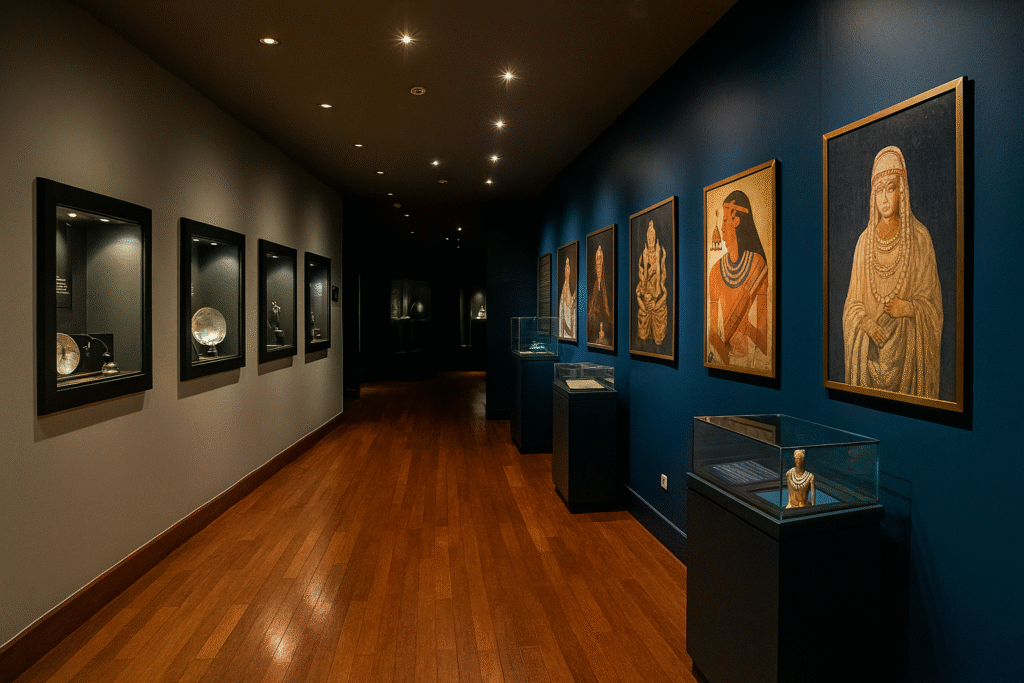The Robert Wan Pearl Museum in Tahiti is the only museum in the world dedicated solely to pearls. Located in Papeete, it actively immerses visitors in the fascinating story of these luminous gems, from myths and legends to modern pearl farming techniques.
Additionally, at this Tahitian pearl museum, you’ll explore how pearls shaped civilizations. Ancient Chinese records describe pearls as “tears of the moon,” while in Rome they symbolized wealth and status. Meanwhile, in Polynesia, pearls were considered gifts from the gods. Research shows that over 70% of early civilizations valued pearls as sacred or royal objects.
One of the main highlights is the world’s largest round Tahitian cultured pearl, a 26mm silver-grey gem weighing 8.7 grams, named the Robert WAN. Specifically, seeing this rare treasure helps visitors understand why Tahitian pearls are considered the “black gold” of the Pacific. As a result, visitors gain insight into both the craftsmanship and cultural significance behind these gems.
Furthermore, visitors learn the steps of pearl cultivation. For example, grafting demonstrations show how oysters produce pearls, while exhibits display the range of colors and shapes unique to Tahitian varieties. In addition, other displays highlight the history of pearl legends across cultures. Also, interactive sections guide visitors through the nuances of choosing the perfect pearl.
Exhibits at the Robert Wan Pearl Museum
- Pearl history across cultures: Asia, Rome, and Polynesia
- Pearl legends: Myths about divine origins and symbolism
- Tahitian pearl farming techniques: Step-by-step cultivation
- Largest pearl display: The 26mm Robert WAN
Moreover, learn more about Understanding Tahitian Pearls to complement your visit.
Why Visit the Robert Wan Museum in Tahiti?
- Only pearl museum in the world
- Perfect for travelers interested in Tahitian culture
- Combines history, craftsmanship, and art
- Offers a boutique with authentic cultured pearls
. Planning your Tahiti trip? Check the guide on Best Things to Do in Tahiti.
. Looking to buy pearls? Read the Pearl Buying Guide.
. Interested in other gems? Explore the History of Gemstones.
Additionally, visit the official Robert Wan website for more details on Tahitian pearl farming and artistry.
“Every pearl carries the story of the ocean and time itself.” – Robert Wan
FAQs About the Pearl Museum in Tahiti
Q: Where is the Robert Wan Pearl Museum located in Tahiti?
A: The museum sits in Papeete, the capital city of Tahiti, and guides visitors easily from the cruise port and downtown area.
Q: What makes this Tahitian pearl museum unique?
A: Experts recognize it as the only museum fully dedicated to pearls, with exhibits covering history, legends, and pearl farming.
Q: How long should I spend at the Robert Wan Museum?
A: Most visitors spend about 1–2 hours exploring the exhibits and boutique.
Q: Can I buy Tahitian pearls at the museum?
A: Yes, the museum boutique actively sells certified cultured Tahitian pearls.
Q: Is the museum family-friendly?
A: Yes, children enjoy the pearl farming displays and stories about pearls.
Introduction
This Responsible Travel FAQ provides comprehensive answers to help you make ethical tourism choices.
Our guide covers eco-friendly accommodations, local community support, sustainable transportation, cultural respect, wildlife ethics, and ways to reduce waste.
Following these practices ensures your adventures benefit both destinations and travelers.
What is Responsible Travel and Why Does It Matter?
Responsible travel means making conscious choices that minimize negative impact while maximizing benefits for local communities and the environment.
Tourism generates $1.4 trillion annually but produces 8% of global carbon emissions.
Your travel decisions affect local economies, cultural preservation, and environmental conservation.
How Do I Choose Sustainable Accommodations?
Look for eco-certifications such as:
- Green Key
- LEED building standards
- EarthCheck approval
- Rainforest Alliance verification
Check if hotels use renewable energy, water-saving systems, and source food locally.
Ask about waste reduction programs and community involvement. Calling properties directly helps verify claims.
Transportation Options for Responsible Travel
- Train travel emits 80% less carbon than flying for similar distances.
- Choose direct flights when necessary and book economy class.
- Use public transport, bicycles, or walk instead of renting cars.
- Consider verified carbon offsets for unavoidable flights.
Supporting Local Economies
- Buy from locally-owned businesses instead of chains.
- Book community-based tours with local guides.
- Eat at family-owned restaurants with local ingredients.
- Stay in homestays or boutique hotels rather than international chains.
- Purchase authentic handicrafts fairly from artisans.
Packing Tips for Responsible Travel
- Reusable water bottle with filtration
- Solid toiletries to reduce plastic
- Reef-safe mineral sunscreen
- Reusable shopping bags
- Bamboo or metal utensils
- Portable laundry soap
Pack light and choose durable, multipurpose items.
Respecting Local Cultures
- Learn cultural customs, dress codes, and etiquette.
- Learn basic local phrases.
- Dress appropriately for religious and conservative areas.
- Ask permission before photographing people.
- Participate respectfully in cultural activities.
Ethical Wildlife Encounters
- Maintain safe distances and avoid feeding animals.
- Choose conservation-focused sanctuaries, not entertainment attractions.
- Avoid elephant rides, direct contact, or photo opportunities with captive animals.
- Use certified naturalist guides who prioritize welfare and habitat protection.
Reducing Waste During Travel
- Use reusable containers, bags, and utensils.
- Refuse single-use plastics.
- Choose digital tickets and receipts.
- Carry a small trash bag where disposal is limited.
Questions to Ask Tour Operators
- Are staff local and fairly paid?
- How does your business give back to communities?
- What environmental practices are in place?
- Are group sizes limited to reduce pressure on sensitive areas?
- Are wildlife experiences ethical and conservation-focused?
Money and Overtourism Practices
- Use local ATMs and tip according to local customs.
- Support social enterprises and cooperatives.
- Visit during shoulder seasons, off-peak hours, or lesser-known areas.
- Stay longer in fewer destinations.
Responsible Travel on a Budget
- Cook using local market ingredients.
- Use public transportation.
- Stay in local hostels, guesthouses, or homestays.
- Explore free cultural events or walking tours.
- Exchange skills or volunteer for free accommodation.
Pre-Travel Research
- Learn about environmental challenges and cultural sensitivities.
- Check seasonal weather and political situations.
- Identify local organizations to support.
- Read destination-specific responsible travel guides.
Creating a Positive Impact Post-Travel
- Share authentic stories on social media.
- Write detailed reviews for responsible businesses.
- Continue supporting local organizations.
- Apply sustainable practices in daily life.
- Recommend responsible travel to others.
Learn more:



